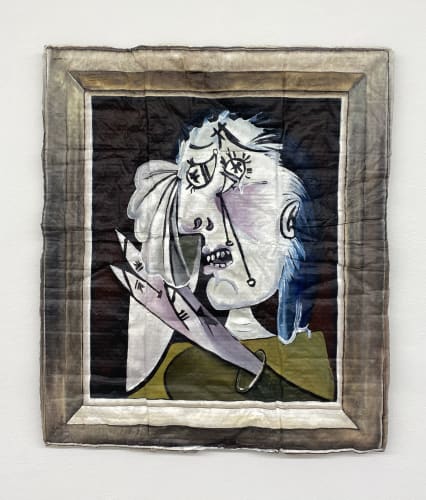The practice of the Spanish painter and street artist Julio Anaya Cabanding (Málaga, 1987) has so far been characterised by reproducing ‘masterpieces’ of Western art on worn-out cardboard and graffiti-laden walls.
For his second exhibition at ADN Galeria, titled De carne y éter: Picasso, Miró y Tàpies, Anaya has decided to pay tribute to these three central figures of the 20th century avant-garde, coinciding with the commemorations that will be dedicated to them in Spain between 2023 and 2025. The exhibition is included in the programme of the Barcelona Gallery Weekend 2024.
The Opening will be attended by the artist.
Made on fragile media, the trompe-l'oeil paintings by Julio Anaya Cabanding (Málaga, 1987) establish dialogues with works from a historical moment that is not our own. Irreverent in practice but respectful in technique, Anaya Cabanding's copies examine certain ideas that have to do with authorship, authenticity and ownership, as well as with the competencies of the institutions that govern the art world, such as the conservation and transmission of a legacy.
Along these lines, De Carne y Éter includes versions of iconic works such as Picasso's La femme qui pleure (1937) and La siesta (1932), and Tàpies' Tela blanca amb cartró cosit (1963). By recreating these works halfway between copying and meta-painting, Anaya pays tribute to these artists and also invites the public to reflect on the condition of their artistic methodology - acrylic painting on abandoned cardboard - and to reflect on the nature of their work.
The use of humble materials in Julio's work establishes a direct connection with the claim of the historical avant-gardes to explore the possibility of elevating everyday objects to artistic status. But cardboard is not the only medium with which Julio Anaya works. The ephemeral impact of his works has also been transferred to the street. Although many of them have been erased or damaged, Julio's ‘tributes’ have also populated the walls of Malaga's urban environments.
From the beginning of his career, Anaya has questioned the value of a work according to its place of exhibition, questioning the traditional notions of validation and prescription that we tend to associate with museums and the rest of the agents in an artistic context. Something that, if we go back to the list of syntonies between Julio's work and the ambitions of modern art, connects with that of fusing art and life and with the question of the accessibility of these two elements to everyone.
In this way, Julio's works seem to approach - beyond the material obviousness - the concept of the ‘poor image’, that which has already been squeezed and worn out by copy-paste and its indiscriminate use. Considered in this way, perhaps the impression that Julio's productions allude to a reference in the history of art that holds the title of original, whose translation in Julio's cartoons would be a re-production, thus extending the original/copy debate, is perhaps erroneous. On the contrary, what Julio works with is its condition as a remixed, phantom image, exploited and distributed through channels other than the official ones.
Julio's proposal has the capacity to inscribe itself in so many debates initiated during Modernity that it shows the pertinence of his work from different points of view. Firstly, because it shows to what extent these debates remain unresolved in our present - or perhaps we are still living with their poor resolution. Secondly, because it points to the exhaustion of the concepts with which we have approached these same debates: ‘transhistoricity’ (Jameson), ‘authenticity’ (Adorno) or the ‘poor image’ (Hito Steyerl). It is precisely this that should be seen as one of the important ‘themes’ of Julio's work, beyond homage, meta-painting and the urban condition.
The exhibition will open on 19 September at 12 noon at ADN Galeria (C/ de Mallorca, 205, L'Eixample, 08036 Barcelona), and will remain open to the public until November 9th.
The practice of the Spanish painter and street artist Julio Anaya Cabanding presents a challenge to the history of art. On worn cardboard and graffiti-laden walls, he reproduces masterpieces of Western art. In contrast to their fragile environments and substrates, his trompe l'oeil works establish transhistorical dialogues with the works of past masters. Irreverent in practice but respectful in technique, Anaya Cabanding's prints examine ideas concerning authorship, authenticity and ownership, as well as the competencies of the institutions that govern the historical and contemporary art worlds, such as conservation and transmission.
Throughout his career, the artist has participated in solo and group exhibitions in museums and art centres such as the Russian Museum Collection (Malaga, ESP) or the Kulturpalast Rabenstein (Chemnitz, GER). His works are part of collections such as Genalguacil Pueblo Museo Collection (Málaga, ESP.), Casa Sostoa Collection (Málaga, ESP.), Begehungen Collection (Chemnitz, GER)- Collection Diputación de Malaga (Málaga, ESP) - Collection of the University of Málaga (Málaga, ESP).
September 19, 2024



